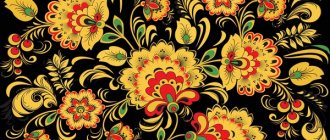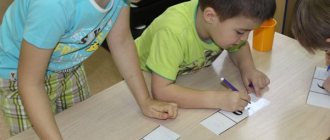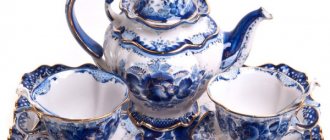History of the fishery
The fishery arose in the second half of the 17th century in the villages of the Volga region. Khokhloma is a large painting corresponding to the name. A characteristic feature is the gilding of wooden surfaces and generous decoration with various patterns. The free brush style made it possible to work in two key directions at once: background painting and riding composition.
On the left bank of the Volga there were many villages where fishing flourished. Residents of the villages of Glibino, Khryashi, Shabashi, Bezdely, and Mokushino brought goods to Khokhloma for sale. The true homeland of Khokhloma is the Koverninsky district of the Nizhny Novgorod region.
The “gold” coloring is often associated with the Old Believers of the Volga region. They persecuted the “old faith” and settled in deep forests. Among them were many talented artists who, using fine brushwork, painted icons and decorated ancient books. Residents of the Volga region excelled in turning and wood carving. The fusion of two traditions gave rise to the birth of Khokhloma craft. It absorbed the rich presentation and pretentiousness of the icon painters, as well as the traditional forms and impeccable lines of the Trans-Volga region masters.
There are also several beautiful legends. One of them is about the icon painter Andrei Loskut, who at one time fled the capital due to the reforms of the patriarch. He found shelter in a deep forest and continued to paint icons “the old fashioned way. However, the patriarch was informed about the whereabouts of the fugitive and that he was teaching the “old” icon writing to the residents of nearby villages. The rebel icon painter voluntarily burned himself in a fire, before bequeathing to his students to preserve his skill.
According to another legend, in the thicket of the forest there lived an unknown master, with whom he himself invented such a luxurious letter on wood. From time to time he presented the residents of nearby villages with his creations. After some time, the fame of the wondrous master reached the king. He immediately sent his subordinates into the forest to bring the founder of Khokhloma to the chambers. However, the master did not want to submit to the king. The talented stranger was never found. So the simple trade was not taken away from ordinary people.
Dishes and more
Craftsmen from the Volga region produced a wide range of household items: boxes, snuff boxes, tables, cabinets. Golden Khokhloma was made to order, but the price for such products skyrocketed. However, this did not bother consumers; everyone wanted to become the owner of a unique painting.
Since the nineteenth century, Khokhloma toys and other goods decorated with beautiful ornaments began to become more expensive. The reason was hidden in the fact that the production process had become significantly more complicated. Craftsmen increasingly began to use floral patterns. Yes, they adhered to the ancient traditions of painting, but at the same time they introduced into it a special style of writing, which distinguishes the craft from other types of craft.
| Over time, the products became noticeably larger. Craftsmen began to use the “kudrin” style, characterized by golden flowers and leaves. The ornament consisted of several individual elements that miraculously merged into a single whole. |
The most revered trend in Khokhloma is “herbal writing”; in the second half of the twentieth century, painters began to use a special ornament. This is how the characteristic features of the fishery were born.
The coloring of the pattern gradually became more complex, the strokes became thinner, and the plot acquired certainty. In central Russia, genres of art appeared that were vaguely reminiscent of Khokhloma: Fedoskino miniatures and Zhostovo trays. A little later, a plant producing Gzhel-style ceramic products started operating.
Colors of Khokhloma painting
(Painted on a white background)
Traditional Khokhloma creations are to some extent paradoxical: the masters managed to create truly complex compositions using a rather meager palette of colors. Richness and interesting texture were formed due to the obligatory golden base. “Golden” was either the background or the key elements of the ornament.
(Painted on a black background)
Other central colors of the palette are black and red. It was possible to give fullness and versatility to the design through the use of white and ocher.
(Painting on an alloyed red background)
Much less common were paintings on turquoise, emerald, orange, and scarlet backgrounds. The true goal of any Khokhloma master: to convey a high idea through perfectly selected colors, creating a complex and high-tech game of brushstrokes.
Primary colors
To create “Khokhloma” paintings, the following colors are used:
- Black(#000000);
- Red(#FF0000);
- White (#FFFFFF);
- Orange (#FF4F00);
- Selective Yellow (#FFBA00);
- Green(#00FF00);
- Brown (#964B00);
- Emerald (#50C878);
- Blue (#00BFFF).
Khokhloma in the song genre
Fine art is often harmoniously combined with other areas of creativity. Khokhloma painting, the history of its development, was no exception. For several years now, a song dedicated to folk crafts has not lost popularity. It is performed solo or by entire groups.
A beautiful melody, touching and heartfelt verses cannot leave you indifferent. By the way, the song “Khokhloma” has repeatedly become a laureate of music competitions.
Elements and motifs of Khokhloma painting
There are “top” and “background” writing. In the first case, the master forms a pattern on a golden background using black, red and white tones. It is through the example of Khokhloma drawings that one can very clearly examine the entire “soul” of the Russian people, the special presentation, the warm and slightly naive philosophy of life of an entire people. These are his well-known “grass” and “spikelets”, his love for still lifes, where the masters especially generously used bright rich colors, and the ability to create complex compositions using delicate strokes.
(Branches and bushes)
The grass painting is represented by sedge-like motifs. The oldest type of pattern is written with curls, strokes, small berries, and spikelets on a silvered background. From individual blades of grass, skilled craftsmen could form a motif of a hen or a cockerel, which, for example, sits on a branch among dense foliage;
(Berries and leaves)
“Berry” and “leaf” differ from the previous technique in larger “bold” strokes. Masters form oval leaves and round berries, stylizing compositions with massive plant forms. Particularly popular are patterns with grape bunches or leaves, strawberries, raspberries, blueberries, and large cherries. On a scattering of tulips, asters, buttercups, daisies, and bluebells, the craftsmen managed to arrange currants, gooseberries and rowan;
(Stitches and patterns)
“Gingerbread” or “saffron milk cap” is usually made inside cups, dishes, and bowls. These are geometric shapes that fit into a square or rhombus. By . The periphery of the ornament is enriched with miniature details.
(Floral ornaments)
Horse writing is always created with thin, delicate strokes. The composition turns out light and airy, as if illuminated by a golden glow from within. As a rule, this is a fairly simple method of applying paints, allowing you to improvise to some extent, modifying the composition at your discretion in the midst of work.
When writing background writing, a canvas with outline outlines is initially formed. Then the surrounding background is painted over with red and black paint. Background painting is a more complex and time-consuming process. There is no room for improvisation here, and the original idea must be implemented exactly as the master came up with at the very beginning.
Program content:— to cultivate in children a love for Russian applied art, to expand and enrich children’s knowledge;
- create a desire to master drawing skills based on Khokhloma painting;
- teach to see beauty and originality in the products of Khokhloma masters, develop artistic taste;
- introduce the element “grass”, pay attention to the smoothness of the lines, consolidate the technical techniques in drawing this element.
Material: screen, finished products of Khokhloma masters: cups, spoons, illustrations, pointer, strips of white paper, brushes, green gouache.
Preliminary work: examining the products of Khokhloma masters, illustrations, making an album together with the children.
Progress of the lesson
Teacher (reads a poem).
Khokhloma painting - a scattering of scarlet berries,
Echoes of summer in the green grass.
Groves, copses, silk splashes
Sunny honey golden foliage. Guys, you already guessed that this beautiful poem was written about the products that you see on my table. And they were painted by wonderful craftsmen. This painting is called Khokhloma.
This painting originated a long time ago. It got its name from the name of the village of Khokhloma, where they began to decorate wooden products. Then, in other quiet Volga villages, lost in the wilderness of endless forests, they began to paint wooden accessories of peasant life. All these items (display) are made of wood and then painted. Please note that the design appears to be gold, but no gold is used in the preparation of these items. Wooden products were covered with liquid clay - “wapa”, soaked in raw linseed oil, puttied, and covered with drying oil. When it dried, the products were covered with a layer of aluminum powder. Then they were painted, dried, rubbed with drying oil, varnished twice and hardened in an oven. The varnish darkened and gave the product a golden hue. You see how many times the master picked up the same thing, how long and how lovingly he worked.
Let's look at what's on my desk. Pay attention to the elements of the painting. What do you see?
Children can easily recognize berries, flowers, and leaves.
Educator. What colors do the masters use?
Children. Red, green, yellow, black.
Educator. The masters apply the drawings with a precise, confident movement with a flexible brush, making a smooth bend of the branch, as if bending under the weight of a ripe berry, the graceful “tendrils” of thin grasses are about to sway in a light wind. Khokhloma masters know many wonderful painting techniques - here there are large golden flowers on a red background, and ancient “grass” painting - thin, thin black and red grass curls merrily across a golden background.
These things serve as a wonderful decoration for any room, and at the same time they are necessary and useful in everyday life. The room becomes brighter and more comfortable from the warm golden shine of Khokhloma products.
Today we will get acquainted with one of the main elements - “weed”. See how to draw it correctly. We take a little green paint onto the tip of the brush and draw a line from top to bottom, but it is not straight, but slightly curved, as if swaying in the wind. We draw the line smoothly, without lifting the brush from the paper.
Children are asked to repeat how to draw “grass.” Individual work is carried out during the lesson.
Analysis. Three guys choose works where the grass is drawn smoothly, neatly, and the line is thin. Why did you choose this job? How are the lines drawn? What's positive about it? What is the quality of work?
Self-analysis using color signal circles.
Technique for performing Khokhloma painting
(In the artistic painting workshop, Semenov, USSR)
Prepared wood products are dried and primed using wax or liquid clay. The blanks dry for at least 7 hours. Then the wooden surface is carefully treated with drying oil. In total, the procedure must be repeated 3–4 times throughout the day.
The next stage is tinning. Aluminum powder is rubbed into the wood. The procedure is carried out manually using a leather swab. After this, the products become shiny and ready for painting.
Only thin brushes of different “calibers” are suitable for applying the design. The finished drawing is left to dry for a while and then opened with varnish. The final stage is hardening in an oven at a temperature of +160 degrees. It is then that a luxurious “golden” film is formed.
Khokhloma - what is it from the point of view of the world community?
In the mid-nineteenth century, the fame of Khokhloma painting reached foreign countries. In 1889, an exhibition was held in the capital of France. It was she who opened the way for “golden art” to all the world’s continents. Russian handicraft products could be found in the markets of India, China, Western Europe, etc.
The incredible popularity of the products of Trans-Volga craftsmen has become an excellent incentive for the further development of the industry. The assortment has expanded significantly; in addition to spoons and cups, glasses, mugs, kegs, etc. have gone on sale. The greatest demand in the West was for bratins - huge vessels in the shape of a boat with a dozen ladles. The product was intended for a mass feast.




